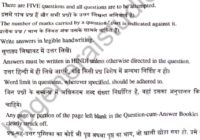HPAS Mains 2021: Hindi Paper
HPAS Mains 2021: Hindi Paper – Download Now HPAS Mains 2021: Hindi Paper – Download Now HAS/HPAS Main 2019 (held in 2020): HAS Main Exam 2019 [Hindi Paper] HAS Main Exam 2019 [English Paper] HAS Main Exam 2019 [Essay Paper] HAS Main Exam 2019 [General Studies Paper-1] HAS Main Exam 2019 [General Studies Paper-2] HAS… Read More »







